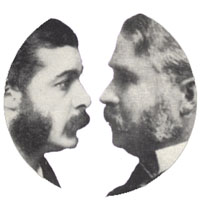
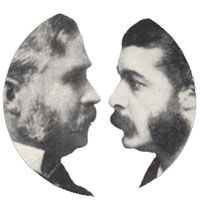
|
Gilbert
& Sullivan
|
|
a
selling exhibition of memorabilia
|
|
THE GOLDEN LEGEND Sullivan-signed and amended proof vocal score |
 |
|
 |
|
Although this item was sold through this website on 29th February 2005, the original owners felt that it was important that its contents remain available to students. The original score has been purchased by the Theatre Collection at Harvard University, and all research enquiries should be directed there. A copy of the score can be viewed at the Royal College of Music Library in London (where the manuscript scores for both "The Golden Legend" and "The Yeomen of the Guard" reside), and for the time being this page will also remain as a further source of information about the score. |
|
Sir Arthur Sullivan began work on his cantata, "The Golden Legend", on 24th April 1886. Chorus rehearsals started on September 10th, and it received its premiere on 16th October 1886, at the Leeds Festival in the North of England. The lyrics were by Joseph Bennett, adapted from Longfellow's poem of the same name. Although relatively unappreciated in the post-1914 period, the work was a popular choice for large Victorian choral groups; only "The Messiah" received more public performances by British choirs in the last quarter of the C19th. The vocal score was first published in an Octavo edition in 1886, by Novello, Ewer & Co. of London. It is believed that the choir at the first performance held printed scores, but whether these were identical to the first published score is unclear. |
|||||
|
|
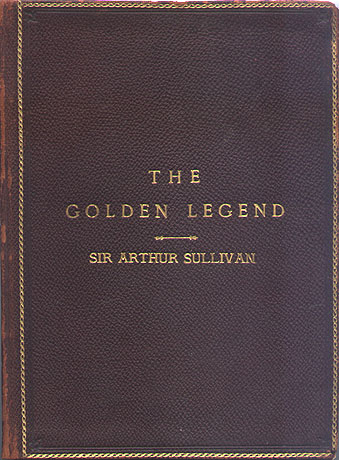 |
||||
| This privately-bound set of proof pages for that vocal score, signed and dedicated by Arthur Sullivan to one Samuel Aitken, and including a set of corrections to the stage directions and dynamics in a different hand, most likely Joseph Bennett's, was found in a school attic in the South of England in the Winter of 2004, and sold by C20th for the benefit of the school music fund. | |||||
|
|||||
| Privately bound by a Cardiff printer, James Wood & Son of Cardiff (1882-1955), the score has a brown leather binding with the title and decorative border embossed in gold. The spine has no title, but bears a series of gold-embossed lines. The endpapers are of feathered paper and the page edges are gilded. Each page has a black border and wide margin at the right-hand edge. These margins were trimmed in binding, and where corrections were made which extended too far to the right, the page has been folded inwards, forming a small flap. Pages are printed on one side only, and each has the title of the work and publisher's name at the bottom. Where a page is not numbered at the top, this is included in parentheses in the footer. | |||||
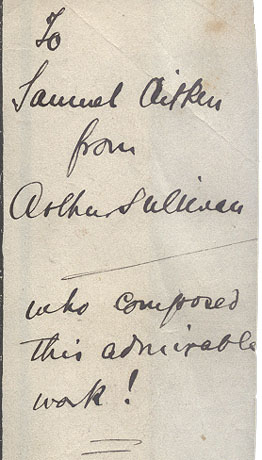 |
|||||
|
There is no title page; the score starts on page one with the first bars of music, (which are rather different from the first published edition, as discussed later). Sullivan's dedication on the page one flap reads, "To Samuel Aitken from Arthur Sullivan who composed this admirable work !". This seemingly pompous description of his own work can only be explained by the fact that Sullivan and Aitken were sharing a private joke. Surprisingly little is known about Samuel Aitken; he was elected to the Committee of Management of the Royal Academy of Music in 1895 but whether he was a composer, teacher or administrator is unknown. He had been proposed to the RAM in 1894 by the composer Sir Alexander Mackenzie, who is known to have had dinner at Aitken's Cardiff home in in 1886. Mackenzie conducted the first London performance of "The Golden Legend", so it is possible that all three men were friends at this early date. However, our research has discovered a more concrete link between Aitken and Sullivan, as both were members of the Board of the Associated Board of the Royal Schools of Music between 1896 and 1900 (Aitken was Honorary Secretary for some of this period). Since this committee met monthly during term-time, and consisted of just twelve members at any one time, there was plenty of opportunity for Sullivan and Aitken to interact. We can imagine Aitken praising Sir Arthur's cantata, describing it as "admirable"; the gift of the pages of the proof score reflecting his comments. Presumably it was Aitken who ordered the binding of these pages in Cardiff at some point after the gift was made. |
|||||
| In addition to the dedication, the score includes a number of amendments: | |||||
|
Ax x |
|||||
| Page 36: Two changes. The word "disappearing" was added to the first line, "Drink, drink..". (The edge of this annotation has been bound into the spine of the score). This dynamic appears in the published score, but the line is also clearly given to Lucifer, this point being unclear in the proof. Further down the page the stage direction for Prince Henry, "drinking", has been changed to "drinks". This latter change does not appear to have been made. | |||||
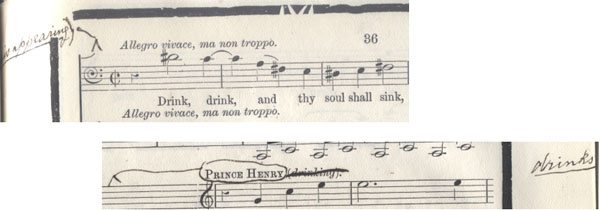 |
|||||
|
x x |
|||||
| Page 44: From the first line of the scene setting, "Driven from his home, as accursed of God, Prince Henry is sheltered in the cottage of one of his vassals" was deleted. This change was made in the published score. | |||||
 |
|||||
|
A x x |
|||||
| Page 69: The setting was changed from "the road to Genoa" to the "road to Salerno". (The final "o" was lost in binding). The change was accepted. | |||||
 |
|||||
|
A x x |
|||||
| Page 75: Where the basses sing "Cujus, faber...", the direction, "in the distance", was deleted but Bennett (or Sullivan ?) may have had a later change of mind, as this remains in the published score. | |||||
 |
|||||
|
Ax x |
|||||
| Page 85: In the final line, "night" was changed to "evening" (again trimmed slightly). An accepted alteration. | |||||
 |
|||||
|
Ax x |
|||||
| Page 97: What appears to be a full-stop was inserted between "Lucifer" and "Salerno". In the published edition this is a comma. | |||||
 |
|||||
|
A x x |
|||||
| Page 117: The setting was changed from "Prince Henry and Elsie standing on the Terrace at evening.", to "Prince Henry and Elsie stand on the Terrace. It is the evening of their marriage day." | |||||
 |
|||||
|
A
|
|||||
|
At Bennett's suggestion Sullivan changed the opening of the piece, shortly before the first performance, adding a peal of bells in the first bar. Another late change to the piece was a reworking of the first bars of the choral epilogue, and as the latter change is represented in this proof, while the former is not, we must assume that it was printed at some point between these two amendments. |
|||||
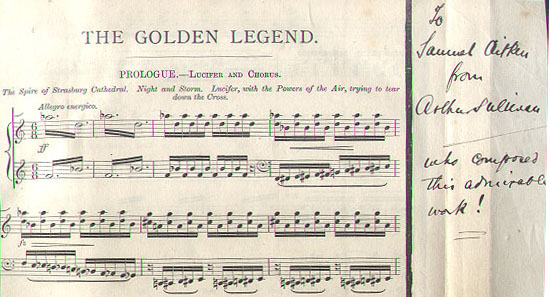 |
|||||
|
|
|||||
|
In addition to the major differences between the proof copy and the published score, there are other minor ones affecting the music, and in particular the dynamics of the piano accompaniment. For example, on page six there are the following discrepancies between the two: In the first bar, the alto line is not denoted as such, although the soprano line is. Bar two: the piano line omits the forte symbol. At bar eight the vocal lines are not marked mezzoforte. Page six is far from an exception, as we have noted many minor errors and changes in this proof score; on page sixty-three's footer, "edition" is misspelled "eition" ! A detailed study of all these minor changes and omissions would be fascinating. Sullivan's diary for 1886, now at the Beinecke library at Yale University, gives a likely date for his revisions to the proof score, as he there recorded that he had, "corrected final revise of v. score at Novello's", on September 18th. It is quite likely therefore that the proof on sale here contains the draft as it stood before his musical amendments on that date. |
|||||
| C20th Homepage | CONTACT | G&S Homepage | ||
|
Thanks We'd like to thank the following for their help in researching the background to the Golden Legend proof score: Tony Davidson (Cardiff Local Studies Library), Robin Gordon-Powell, Roger Harris (R. Clyde Publications), Dr. Peter Horton (Royal College of Music Library), Dr. D. Russell Hulme (The University of Wales, Aberystwyth), Stephen C. Jones (Beinecke Library), Bridget Palmer (Royal Academy of Music Library), Marc Shepherd, Ruth Turner (Associated Board Library), J. Rigbie Turner (Pierpont Morgan Library). |